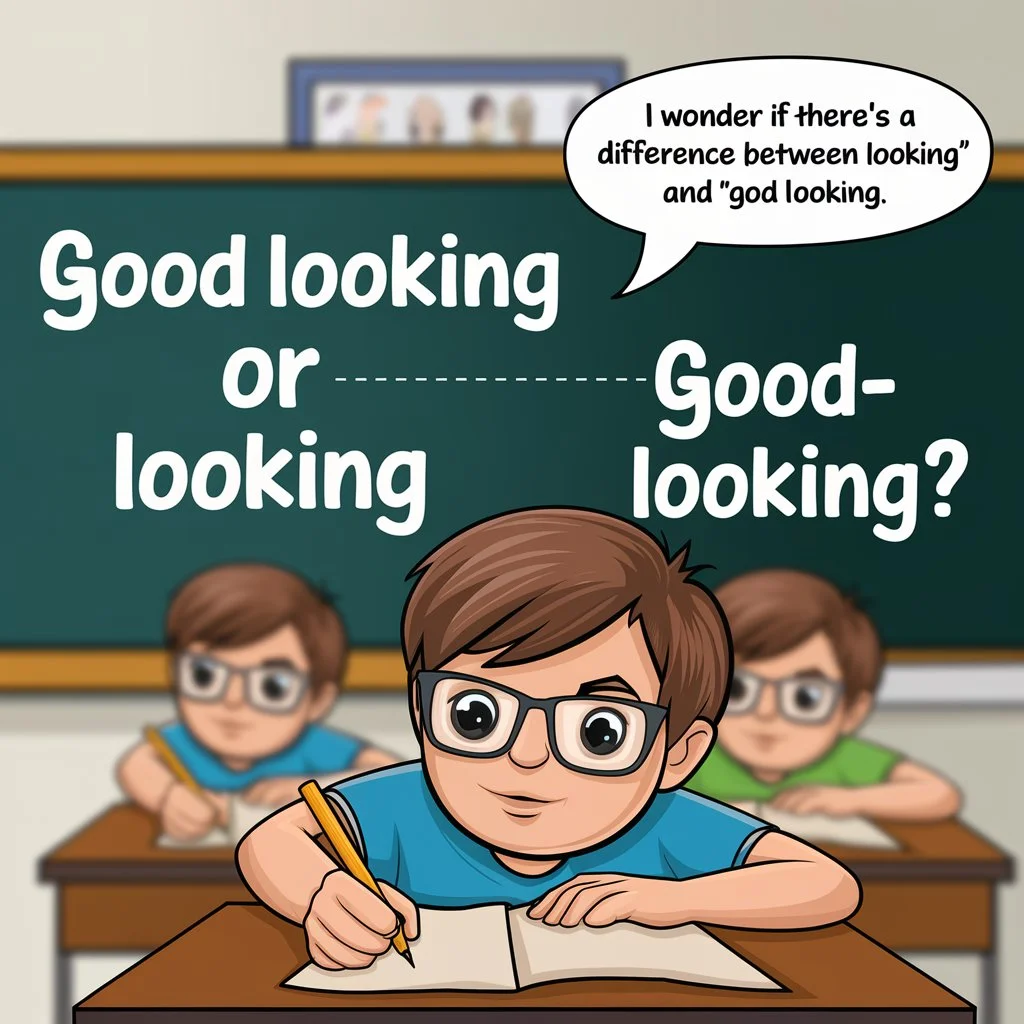In today’s discussion, we’re exploring whether “good-looking” should be hyphenated or left as two separate words. Understanding hyphenation rules can make a big difference in your writing, and once you learn one rule, others tend to follow the same pattern. So, what’s the right choice? Is it “good looking” or “good-looking”?
When writing, we often come across the term “good looking” or “good-looking” and wonder about the correct usage. Should we use the hyphen, or is it fine to leave it out? Understanding hyphenation rules can be tricky, but once you learn the basics, it becomes easier to apply them. In this post, we’ll break down when to use “good looking” versus “good-looking” and why. By the end, you’ll have a clear understanding of the correct usage and the rules behind it.
When To Use “Good-Looking” Or “Good Looking”
The answer to the good-looking hyphenation rule depends on how the phrase is used in a sentence. You should hyphenate “good-looking” when it functions as an adjective that modifies a noun. In contrast, use “good looking” without a hyphen when it acts as a noun at the end of a clause or sentence.
Examples Of When To Use “Good Looking”
Let’s first examine the use of “good looking” without the hyphen. Many believe that this phrase is always hyphenated, but that’s not the case. According to AP style, “good looking” is left unhyphenated when it stands alone as a noun and does not modify anything. In these instances, there is no need for the hyphen.
- He is really good looking.
- My dog is good looking.
- That girl is so good looking.
- You are good looking.
- My son is good looking.
- He is really good looking.
- My dog is good looking.
- That girl is so good looking.
- You are extremely good looking.
- My son turned out to be quite good looking.
- That actor is known for being good looking.
- She said her new boyfriend is good looking.
- The model on the cover is incredibly good looking.
- People say my brother is very good looking.
- After the makeover, she looked really good looking.
- He was always considered good looking by his peers.
- Everyone agrees that your husband is good looking.
- In high school, he was the most good looking guy.
- That celebrity has always been good looking.
- I never realized how good looking she is.
Side note: While it’s technically correct to say “good looking” without the hyphen, the English language is evolving. Today, many writers prefer to use “good-looking” in all contexts, regardless of its grammatical role.
Examples Of When To Use “Good-Looking”
Now, let’s explore when the hyphenated version, “good-looking,” is required. This form is most commonly used when “good-looking” modifies a noun or object. It acts as an adjective, providing additional information about the noun. Below are examples of the hyphenated form:
- He is a good-looking man.
- That’s a really good-looking cake.
- I can’t get over that good-looking castle.
- You’re a good-looking girl.
- We’re a good-looking family.
- He is a good-looking man.
- That’s a very good-looking jacket you’re wearing.
- She brought a good-looking dessert to the party.
- We saw a good-looking house by the beach.
- You have a really good-looking car.
- They make such a good-looking couple.
- I bought a good-looking suit for the event.
- The chef prepared a good-looking plate of food.
- He is a good-looking actor from the movie.
- That’s a good-looking painting you made.
- She met a good-looking guy at the bar.
- The hotel had a good-looking lobby area.
- This is one good-looking family photo!
- They live in a good-looking neighborhood.
- She wore a good-looking dress to the wedding.
Is “Good Looking” Hyphenated In AP Style?
According to the AP Stylebook, hyphens are “joiners”. They link two or more words together to function as a single adjective that modifies a noun. This helps readers understand that the two words are meant to be read as a unit. However, when the phrase acts as a standalone noun, AP style advises leaving it unhyphenated.
Should I Capitalize “Looking” In The Word “Good-Looking”?
Capitalization rules vary based on the style you’re following when writing titles. Here are three main styles to consider for capitalizing “good-looking”:
- Capitalize only the first word: In this style, “good-looking” would remain lowercase, with only the first word of the title being capitalized.
- Capitalize most words: In this approach, short prepositions, conjunctions, and articles are left lowercase. So, you’d capitalize “Good” but leave “looking” lowercase.
- Capitalize every word: This style calls for capitalizing both words in “Good-Looking” as they are treated as individual terms.
Alternatives To “Good Looking”
If you find the hyphenation rule confusing, here are some alternative words that do not require hyphens. These alternatives can convey the same meaning without any risk of grammar mistakes:
- Handsome
- Beautiful
- Pretty
- Gorgeous
- Attractive
Quiz – Good Looking Or Good-Looking?
Let’s wrap up with a quick quiz to see how well you’ve grasped the good-looking hyphenation rule. Even though both forms are acceptable, follow AP style rules to ensure you get the answers right. Check your answers at the end.
- I’m a (A. good looking / B. good-looking) person.
- My mom says I’m (A. good looking / B. good-looking).
- That’s a (A. good looking / B. good-looking) croissant.
- You make a (A. good looking / B. good-looking) couple.
- The football team is so (A. good looking / B. good-looking).
Quiz Answers:
- B
- A
- B
- B
- A
In summary, while both forms—good looking and good-looking—are grammatically correct, following AP style will help guide your hyphenation choices. Hyphenate when using the phrase as an adjective, and leave it unhyphenated when it stands alone as a noun.
FAQs
When should I use “good-looking” with a hyphen?
You should use “good-looking” with a hyphen when the phrase acts as an adjective, modifying a noun. For instance, when you say, “He is a good-looking man,” the hyphen connects “good” and “looking” to form a single descriptive term for the noun “man.” Hyphenation makes it clear that the two words function together to describe a noun. Without the hyphen, the sentence could be unclear or awkward.
When should I use “good looking” without a hyphen?
Use “good looking” without a hyphen when it appears at the end of a sentence or as a noun. For example, in the sentence “He is really good looking,” the phrase stands alone and isn’t modifying any other word. This is because the phrase functions as a noun, and there’s no need for the hyphen in this case. AP style guides us to avoid hyphenation when the phrase is a standalone noun.
Is it always wrong to use “good-looking” without modifying a noun?
Though it’s not always wrong to use “good-looking” in all situations, it’s best to follow grammar rules. Many people casually use the hyphenated form no matter where it appears in a sentence, but technically, it’s only required when modifying a noun. Over time, common usage has blurred these lines, but if you want to be grammatically correct, stick with no hyphen when it’s a standalone noun.
What are some alternatives to “good looking” to avoid hyphen confusion?
If you want to avoid the hyphenation issue altogether, there are plenty of great alternatives to “good looking”. You can use words like handsome, beautiful, gorgeous, attractive, or pretty. These words convey the same meaning without needing to worry about hyphen rules. Plus, they can help you vary your vocabulary and make your writing more interesting.
Does capitalization change when using “good-looking” in titles?
Yes, capitalization rules can vary depending on your chosen style guide. If you’re following a title case style, you would capitalize “Good” but leave “looking” lowercase, like this: Good-looking. However, in sentence case, you would only capitalize the first word, and the entire phrase would look like good-looking. If using all caps, both “Good” and “Looking” would be capitalized: GOOD-LOOKING.
Can I hyphenate “good looking” in informal writing?
In informal writing, it’s common to see “good-looking” used with or without a hyphen in various contexts. While the grammar rules still apply, people tend to be more lenient in less formal situations. If you’re writing for social media or casual settings, using “good-looking” consistently won’t usually be criticized, but it’s good practice to know the proper rules for formal writing.
Conclusion
Hyphenation can be tricky, especially with terms like “good looking” or “good-looking.” However, once you understand the difference—hyphen for adjectives, no hyphen for nouns—it becomes much easier to write correctly. Whether you’re writing formally or casually, knowing these rules helps you communicate more clearly. Language evolves, and while people may use the hyphen in various ways, it’s still useful to follow the official guidelines. As the saying goes, “Grammar is the backbone of clear communication.” By mastering these rules, you’re ensuring your writing is both professional and precise.

I’m Mira Sinclair, the expert helping you navigate grammar sections at “Grammer Grove.” Playing with words and expressions is my thing. At Grammer Grove, we’re here to make yourwriting stand out and shine. Let’s make your appreciation heartfelt and memorable—come and join the fun at Grammer Grove!












